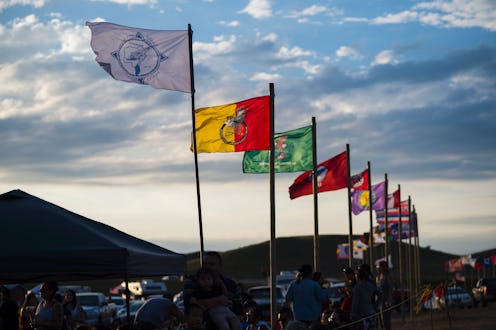News
Valuable Resources For Understanding NoDAPL
This past Sunday, protestors in Standing Rock, North Dakota, who gathered to peacefully demonstrate against the Dakota Access Pipeline construction were struck by water cannons fired by the Morton County Sheriff's Department. The day's near freezing temperatures made the water cannons especially harmful as hypothermia threatened to overtake the soaking wet protestors. This was just the latest in a series of attempts to get rid of peaceful protestors.
The NoDAPL protests have been convening since April 2016 and have garnered increased media attention in recent months as law enforcement has reportedly taken increasingly intense action against those demonstrating against it. Even more people have become aware of the fight against the DAPL via social media, where shows of solidarity have recently gone viral. Although you might have only just become aware of the DAPL and the movement against it, the fight the protestors are waging has deep roots in this country's history of settler colonialism. And while it is important to show support for the protestors working there, it is also important to build a solid foundation of understanding exactly what is going on.
Here are some essential reads and resources for understanding the DAPL, how it came to be, and the civil rights and environmental threats it poses.
A Short History Of The Standing Rock Sioux Tribe
The people of the Standing Rock Sioux Tribe are at the forefront of the movement against the DAPL, and for good reason. The project could contaminate the Standing Rock Sioux Reservation's main source of water, and its construction has already put the tribe's sacred sites and artifacts at risk of destruction. Learn more about the reservation, the tribe, and its makeup and leadership on the Standing Rock Sioux Tribe website.
Resources From Sacred Stone Camp
Camp of the Sacred Stone was formed in early April as a site of resistance against DAPL construction. In addition to sharing updates on the protests via their social media platforms, the camp's website has a great overview of the pipeline project as well as the federal laws it has violated. Find those and other readings on the Sacred Stone Camp's resource page.
Indian Country Today's Special DAPL Edition
Indian Country Today has been providing comprehensive coverage of NoDAPL protests since before the movement finally received attention from larger, mainstream media outlets. This fall, the media network released a special NoDAPL Movement edition of its weekly newsletter composed of its coverage of the DAPL, starting with its report in March announcing the pipeline's plans. One particularly striking piece is "Why I Can't Forget the Whitestone Massacre," in which Sacred Stone Camp founder Ladonna Bravebull Allard tells the story of her great, great grandmother's survival of the Inyan Ska Massacre.
Although much has happened since the newsletter was published in September, it remains an important resource in understanding the NoDAPL movement's development. You can read the newsletter online.
"Reckoning At Standing Rock" From High Country News
In this Oct. 28 article for High Country News, journalist Paul VanDevelder situates the Standing Rock Sioux's NoDAPL movement in the context of America's long history of making and breaking treaties with and enacting violence against Native communities as well as the endurance and successes of Native resistance. This piece is essential reading for anyone looking to learn more about the history of tribal rights in America well as what the outcome at Standing Rock may mean for the future. Read the article here.
Letters From Standing Rock Youth
Youth members of the Standing Rock Sioux tribe have emerged as leaders in their own right with their Rezpect Our Water campaign. Read letters from Standing Rock youth about why they oppose and are protesting DAPL construction.
Resources From The Standing Rock Sioux Tribe's Lawyers
Earthjustice, an environmental nonprofit organization, has a comprehensive FAQ page on their website about the current lawsuit brought by the Standing Rock Sioux Tribe against the U.S. Army Corps of Engineers, who granted the permits necessary for the DAPL's construction. Besides including a timeline of important events and a cache of legal documents, the page is frequently updated with developments in the case and statements from Standing Rock Sioux Tribe leadership.
These are only a fraction of the resources accessible online that can help you learn more about the NoDAPL movement, but they are a great place to start. And of course, informing yourself is just the first step for those interested in fighting against the DAPL and pushing back against our nation's disrespect of Native communities and the environment.
